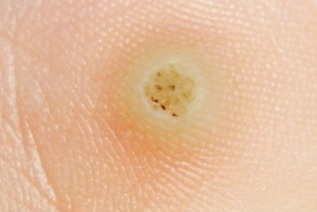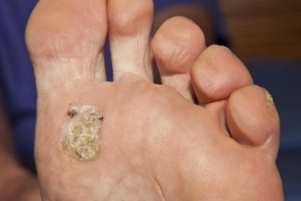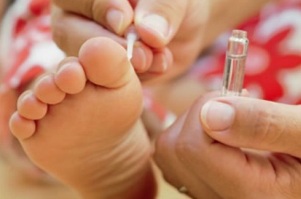
If a hard, rough papule with a rough top appears on the soles of the feet, then this is a plantar or callus wart. The difference is significant, especially in the origin and method of treatment. Warts grow like sharp thorns in the inner layers of the skin of the feet, causing severe pain. Doctors recommend to remove this swelling of the skin if it is damaged due to shoes and becomes inflamed.
Appearance of growth on the soles of the feet
The main part of normal warts in the legs grows inward, into the dermis. The reason is that from the outside the tumor is squeezed by a hard surface: shoes, various layers in which we walk. New growth cells emerge from the soft tissues of the skin. In photos of plantar warts, thick plaques or rollers are visible from the outside. The surface of its formation has no skin line, consisting of scales of horny substances. Adjacent skin changes: becomes denser, covered with a layer of keratin.
What do plantar warts look like:
- nodules or plaques are raised above the epidermis by 1-5 mm; The
- shape is round, oval or polygonal; The
- surface is hard and rough when touched;
- pink, yellow-white or gray;
- diameter of formation from 1 to 20 mm;
- missing papillary pattern;
- the edges are well defined.
Warts on the legs are characterized by acute pain that interferes with walking, resulting in temporary disability.

Accumulation occurs in areas exposed to strong stress and sweat. Special localization of warts on the soles of the feet: heels, soles and toes. Painful and difficult-to-remove formations appear on the edges of the nails and under the nail plate. In all types of warts there are blood vessels that feed on living tissue, cells that multiply intensively. Small black dots appear on the surface - blood clots in the capillaries; they may bleed when the stratum corneum is cut.
Plantar warts are most common in school-age children. In about 30% of patients, such formation disappears on its own in the first year. However, it is recommended to start treatment when the first symptoms appear, especially if the plantar warts are painful, or there is a high risk of being infected by people around them. Infection is also dangerous, when a group of formations appears in one area, individual papules merge into mosaic plaques.
Warts - manifestations of the papilloma virus
The skin on the feet is often damaged, compressed and sweaty when wearing tight and uncomfortable shoes. If a thin-walled blister with clear liquid in it appears, then this is corn. Sometimes a layer of keratin forms on the surface, but even so, special skin lines remain.
The appearance of warts on the soles of the feet is initially unnoticed or considered a callus formation. It is necessary to look at the surface of the formation carefully and pay attention to the characteristic signs. This is severe keratinization, the absence of skin lines, pain when the surrounding skin is compressed. This is the result of active reproduction of the papilloma virus in living epithelial cells.
Causes of plantar warts:
- Infectious papilloma virus (HPV);
- weakness of local and general immune defenses;
- virus activation, penetration into epithelial cells;
- increases the multiplication and keratinization of infected cells rapidly.
HPV is transmitted through domestic and sexual contact. Infectious agents penetrate even through minor damage to the skin and mucous membranes: cracks, wounds, tears.
Papilloma viruses type 1, 2, 4, 27, and 57 infect cells found on the skin of the feet. The plant-derived type of virus comes from a simple (ordinary, vulgar) formation. According to the International Classification of Diseases, they are infectious and parasitic diseases. Class ICD-10: "Viral infections characterized by lesions on the skin and mucous membranes. "
Moderate warts are benign epithelial tumors. They were initially not harmful to health. Sometimes such growth undergoes a malignant transformation into a cancerous tumor. This process is more often triggered by the type of HPV in which high risk of cancer is found.
Leg warts treatment
Once infected, the incubation period begins: the papilloma virus invades the cell, "reformatting" its reproduction and development. Far more often, the infection becomes latent and in an inactive state, it can exist for the life of the organism. Immunity in this case suppresses the papilloma virus, putting it into sleep mode without special therapy.
Plantar warts may appear 3-10 years later or appear a few weeks after infection, then disappear in the first year or two.
Not everyone is ready to wait, depending on the spontaneous healing and cleansing of the skin from growth. Many see a doctor at the first sign of HPV infection. Dermatologists recommend using modern methods to get rid of warts, recommend methods for antiviral therapy, strengthen the immune system of the skin and the whole body.
If for adequate therapeutic options it is necessary to determine the type of HPV, then the doctor prescribes some additional studies. A biopsy was performed to collect histological material, analysis was performed to determine antibodies to the papilloma virus.

Treatment options:
- Use of special medicine for plantar warts. Dissolution and exfoliation of dead cells occurs. Laser cutting from a simple neoplasm with the formation of scabies, where healing occurs. The crust disappears 7-10 days after the procedure.
- Crushing Cryod with liquid nitrogen. Large warts are removed in several procedures. When exposed to low temperatures, bubbles appear, like burns.
- Electrocoagulation uses electrodes where high-frequency currents are used to destroy pathological tissue. The painful procedure is accompanied by a strong burning skin odor.
- Surgical removal.
- Drug injection.
At the beginning of treatment, it is recommended to use a special plaster at home. This affordable medicine is used after softening the warts on the feet with warm water, cleaning it from the keratin layer using nail clippers and pumice stone. Then the patch is applied. The course of treatment lasts for 1-3 months.
Prevention
The papilloma virus can persist in the environment for a long time. Need to keep feet clean, do not go without shoes, especially in public dressing rooms, bathrooms, in the pool. You need to use special slippers to protect the soles of the feet from contact with surfaces contaminated with other skin particles. Also, do not wear other people's socks and shoes.
Do not scratch the warts, otherwise similar growths will appear on the other leg.
Papilloma virus is very contagious. Disinfecting accessories for hygiene applications and daily medicines. Socks and towels should be washed with hot water, scissors, nails, pumice stone should be disinfected. Make sure you wash your hands with soap and water after touching education, various medical procedures.














































































